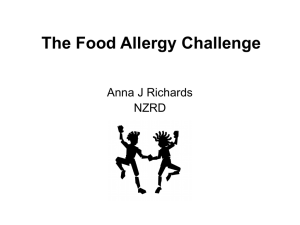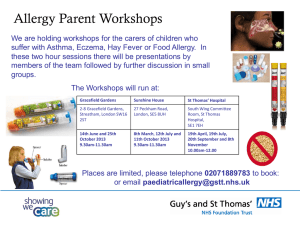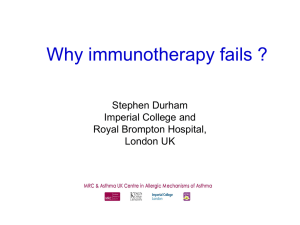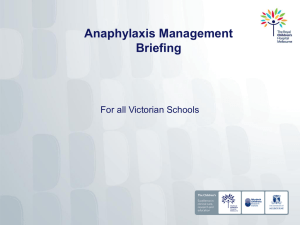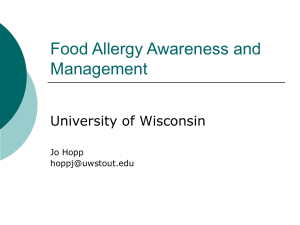Stinging Insect Allergy - Barnstable County Beekeepers Association
advertisement
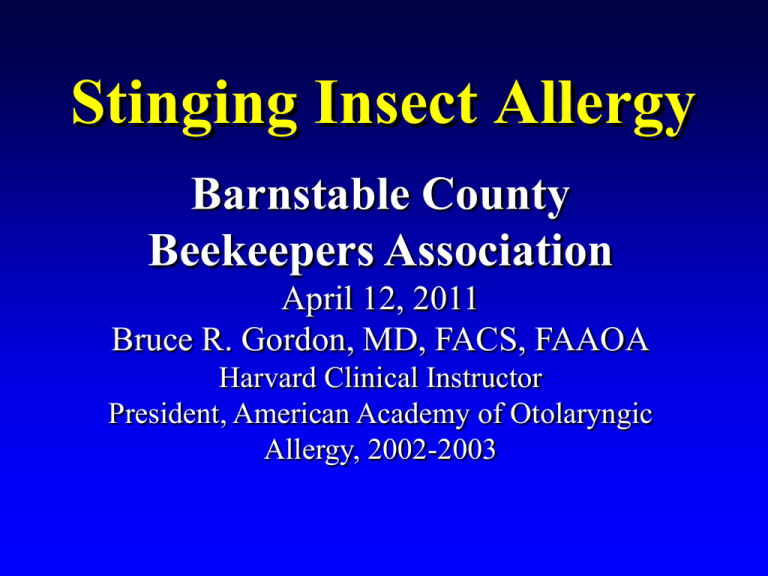
Stinging Insect Allergy Barnstable County Beekeepers Association April 12, 2011 Bruce R. Gordon, MD, FACS, FAAOA Harvard Clinical Instructor President, American Academy of Otolaryngic Allergy, 2002-2003 Objectives Learn to : • Understand sting reaction types • Recognize responsible insects • Understand risk factors • Understand basic treatment of stings • Understand when and how to immunize • Understand when to stop immunotherapy Type of Reactions to Bees • Contact allergy to propolis • Respiratory allergy to hive dust and bee bodies • Asthma and anaphylaxis from royal jelly • Sting reactions: – Toxic reactions – Local reactions – Systemic Anaphylacic reactions Bousquet J, Menardo JL, Michel FB. Allergy in beekeepers. Allergol Immunopathol (Madr). 1982;10(5):395-8. Epidemiology • 26.5% U.S. prevalence of venom sensitization (27.1% in Germany) • > 0.5 to 5% U.S. Severe insect sting allergy • > 40 deaths / year U.S. from insect stings – (does not include suspicious sudden deaths) 1. Neugut AI, Ghatak AAT, Miller RRL. Anaphylaxis in the United States: an investigation into its epidemiology. Arch Intern Med. 2001;161(1):15-21. 2. Schäfer TT, Przybilla BB. IgE antibodies to Hymenoptera venoms in the serum are common in the general population and are related to indications of atopy. Allergy. 1996;51(6):372-7. 3. Valentine MD, Lichtenstein LM. Anaphylaxis and stinging insect hypersensitivity. JAMA 1987; 258:2881-2885 Sensitization Risk from Stings • Frequent stings, especially < 2 mo. apart, sensitize • Very frequent stings, > 50 / yr, desensitize (beekeepers) Pucci S, Antonicelli L, Bilo MB, Garritani MS, Bonifazi F. Shortness of interval between two stings as risk factor for developing Hymenoptera venom allergy. Allergy. 1994;49:894-6 Types of Stinging Insects Stinging insects are order Hymenoptera (membrane-winged insects) • Apids (honeybees and bumblebees) • Vespids (yellow jackets, wasps, hornets, and paper wasps) • Formicids (ants, fire ants) Hymenoptera: Apids (Bees) Risk of being Stung • Domestic honeybees do not sting unless provoked • Bumblebees are not aggressive & rarely sting, but use in greenhouses increases exposure • Africanized hybrid honeybees, common in Mexico and South, are hostile, aggressive, and swarm Africanized Bees 2009 Range Honeybee Stinger is Barbed • Bees leave their barbed stinger and venom sac implanted in their victim • This distinguishes honeybee stings from all other stings: bumblebees, wasps, and ants have no barbs Lewis,FS, Smith, LJ. What’s eating you? Bees, part 1. Cutis 2007;79:439-44 Honeybee Sting Allergy Honeybee venom is very sensitizing –More likely to react on re-sting –More likely to react during immunotherapy treatments –Less likely to be protected by immunotherapy –Less likely to stop immunotherapy Graft DF. Venom immunotherapy: when to start, when to stop Allergy Asthma Proc. 2000; 21:113-116 Africanized Bee Stings • Africanized bees and domestic bees have identical venoms • Africanized bees are much more dangerous due to easy arousal, aggressive stinging, mass stings, and persistent pursuit of the victim Lewis,FS, Smith, LJ. What’s eating you? Bees, part 1. Cutis 2007;79:439-44 Bumble Bee Stings • Ground nesting, < 200 bees per nest • Stinger not barbed: stings repeatedly • Not easily irritated: stings uncommon Hymenoptera: Vespids (Wasps) • Yellow Jackets: ground nesting; very aggressive & swarm - stings cause skin infection • Hornets, Wasps, and Paper Wasps : aerial nesting - in trees, roof overhangs, shutters, under shingles, in attics; not aggressive unless disturbed Hymenoptera: Formicids (Ants) Imported Fire Ants found in SE and Gulf coast; will spread much further north & west from global warming Ants bite, and deliver multiple stings in circular pattern; aggressive & swarm - attacks 6 - 60% of people living in an area during each year. Harvester Ants (native fire ants) found in SW; stings painful, but fatalities rare Imported Fire Ant Range At Risk: Pacific Northwest, Arizona, Virginia Tracy JM, Demain JG, Quinn JM et al. The natural history of exposure to the imported fire ant (Solenopsis invicta). J Allergy Clin Immunol 1995; 95:824-828 Sting Risk Factors Risk Factors for Serious Sting Reactions 1 Survey of 494 beekeepers: • 90% stung/year, 55% had >100 stings • 6.5% had serious reactions • Risks: having any kind of allergies, especially asthma, food allergies, or multiple kinds of allergies Celikel S, Karakaya G, Yurtsever N et al. Bee and bee products allergy in Turkish beekeepers: determination of risk factors for systemic reactions. Allergol Immunopathol (Madr). 2006;34(5):180-4. Risk Factors for Serious Sting Reactions 2 Survey of 1053 beekeepers: • annual stings/person 0-1000, average 58 • 4.4% had serious reactions • Risks: current allergy symptoms, having allergies, years as beekeeper, stings in spring Münstedt K, Hellner M, Winter D, et al. Allergy to bee venom in beekeepers in Germany. J Investig Allergol Clin Immunol. 2008;18(2):100-5 Developing Bee Allergy in New Beekeepers 35 new beekeepers tested for 5 years: • 29% became venom sensitive • most within 12 months, all by 18 months • number of stings and presence of other allergies had no effect on developing sting allergy Kalogeromitros D, Makris M, Gregoriou S et al. Pattern of sensitization to honeybee venom in beekeepers: a 5-year prospective study. Allergy Asthma Proc. 2006;27(5):383-7 Predicting Risk of Serious Reaction in Beekeepers 78 beekeepers studied before being stung Risks are: • pre-exposure high IgE blood test > 1 ku/L • allergic nasal, eye, or lung symptoms during hive work • less than 8 years beekeeping • prior serious sting reaction Annila IT, Annila PA, Mörsky P. Risk assessment in determining systemic reactivity to honeybee stings in beekeepers. Ann Allergy Asthma Immunol. 1997;78(5):473-7. Consecutive Stings increase Anaphylaxis Risk 120 sting-allergic persons: • 59% of serious reactions occur when there was a prior sting within 2 months (p=0.0001 - highly significant) Pucci S, Antonicelli L, Bilò MB et al. Shortness of interval between two stings as risk factor for developing Hymenoptera venom allergy. Allergy. 1994;49(10):894-6. Fewer Stings increase Anaphylaxis Risk 176 sting-allergic beekeepers: • reaction risk is inversely correlated with annual number of stings Bousquet J, Ménardo JL, Aznar R et al. Clinical and immunologic survey in beekeepers in relation to their sensitization. J Allergy Clin Immunol. 1984;73(3):332-40. Types of Sting Reactions • Immediate Allergic – Local, Large Local, Systemic • Delayed Toxic (Non-Allergic) – Serum sickness, CNS demyelination, vascular thrombosis, glomerulonephritis, myocarditis, multi-organ failure, and death – Multiple stings required : LD50 (honeybee) > 500 stings Graft DF. Stinging insect hypersensitivity in children. Curr Opin Ped. 1996; 8:597-600 Immediate Therapy for all BeeStings • Rapidly remove all bee venom sacs envenomation is complete in one minute ! • Use your HIVE TOOL ! Schumacher MJ, Tveten MS, Egen NB. Rate and quantity of delivery of venom from honeybee stings. J Allergy Clin Immunol. 1994;93(5):831-5. Toxic Sting Reactions • Honeybees (especially Africanized) or Wasps (yellowjackets and hornets) • Without treatment, > 20-200 wasp stings or > 150-1000 bee stings can be fatal • Symptoms may not appear for hours to several days • Go to the hospital immediately for any mass sting (call 911 !!!) Vetter RS, Visscher PK, Camazine S. Mass envenomations by honey bees and wasps. West J Med. 1999;170(4):223-7. Allergic Reactions to Insect Stings 1. Local: pain, redness at site 2. Large Local: swelling of extremity 3. Systemic: generalized, involves any symptoms at a remote site from the sting. These may quickly be life threatening. Immediate Therapy for Stings • Local reaction: ice, antihistamine Schumacher MJ, Tveten MS, Egen NB. Rate and quantity of delivery of venom from honeybee stings. J Allergy Clin Immunol. 1994;93(5):831-5. Immediate Therapy for Stings • Large Local reaction: ice, antihistamine, prescription prednisone Schumacher MJ, Tveten MS, Egen NB. Rate and quantity of delivery of venom from honeybee stings. J Allergy Clin Immunol. 1994;93(5):831-5. Immediate Therapy for Stings • Systemic reactions: give epinephrine & treat for anaphylaxis. Call 911 !!! Schumacher MJ, Tveten MS, Egen NB. Rate and quantity of delivery of venom from honeybee stings. J Allergy Clin Immunol. 1994;93(5):831-5. Systemic Reactions • Treat immediately ! • If you think of epinephrine, USE IT ! • Epinephrine 1:1000 (0.01ml/kg) = 0.3 ml adult, 0.15 ml child. Inject into muscle ! • Be ready to Re-Treat. Epinephrine may only last 5-10 minutes. Systemic Reactions • Epinephrine is required more than once in 35% of anaphylaxis cases • Most insurance companies cover dual packs of epinephrine injectors. Buy them ! Korenblat P, Lundie MJ, Dankner RE, Day JH. A retrospective study of epinephrine administration for anaphylaxis: how many doses are needed? Allergy Asthma Proc. 1999;20(6):383-6. Epinephrine Use • Caution after removing safety cap - don’t inject hand • Swing hard • Inject right through your clothes • Hold against leg & count slowly to 10 After Giving Epinephrine • CALL 911 • Keep giving Epinephrine, as often as needed to control symptoms • If patient has asthma, USE THEIR INHALERS • If available, give oral Antihistamine and Oxygen Facts to Remember Clinical History - helps with treatment Important to Identify: • what kind of insect • type of reaction • severity of reaction • ? progression of this reaction over time • ? worse compared to last sting What Insect Was it ? • Winged / flying eliminates Fire Ants • Stinger left in skin : Honeybee • Nest location : ground favors Yellow Jacket (bumble bee less common) • Large size: favors Hornet • Narrow waist: not a bee or bumblebee Which Insects to Test 1 • About 90% of stings are from Wasps • Always test Yellow Jacket (most aggressive, most likely to sting) • If Wasp or Hornet is likely, test all local species • If Africanized bees are local, test Honeybee Pérez-Pimiento AJ, González-Sánchez LA, Prieto-Lastra L, et al. Anaphylaxis to hymenoptera sting: study of 113 patients. Med Clin (Barc). 2005;125(11):417-20. Which Insects to Test 2 • If stinger found, test Honeybee • When unsure, test Honeybee & Yellow Jacket • If stung by Bumblebee (large bee), test for Honeybee and Bumblebee • If poor history, test all local species Why to do In Vitro (Blood) Tests • IgE: – To identify culprit insect ( may be falsely negative in 15-20%) – To determine degree of sensitivity – To differentiate toxic and allergic Rxn – For Safety, prior to Skin Testing • IgG : – To check progress of desensitization Reisman RE. Stinging Insect Allergy. Med Clin NA 1992; 76:883-894 Why to do Skin Tests • If blood test is negative, and suspicion of allergic reaction is high • if immunotherapy is needed, skin test must precede beginning treatment Bee-Venom Allergy without positive Tests • In very rare patients with classic bee sting anaphylaxis history, blood tests and skin tests may both be negative. • If an in-hospital sting challenge is positive, immunotherapy is indicated. Zidarn M, Kosnik M, Drinovec I. Anaphylaxis after Hymenoptera sting without detectable specific IgE. Acta Dermatovenerol Alp Panonica Adriat. 2007 ;16(1):31-3. Management of Proven Stinging Insect Allergy Insect Avoidance – Caution during outdoor activities • Look for nests on ground, roofs – Extra care in Picnic areas • Orchards, trash containers, soda cans, fruit – Wear shoes, long sleeves, pants, gloves – Avoid fragrances, bright colors – Use protective suit, veil, & gloves when working with bees Management of Stinging Insect Allergy • Epinephrine kits – Kits must be with you to be useful • epinephrine stability is poor with oxygen, light, & heat ( replace kits as needed ) – Practice epinephrine use – Always call 911 after epinephrine • Antihistamines & corticosteroids are OK to use AFTER epinephrine Management of Stinging Insect Allergy Venom Immunotherapy (Allergy Shots) - should be considered in all persons who: • have a positive history of one or more Systemic Reactions to stings • have a positive diagnostic test • are likely to be re-stung Who Needs Immunotherapy ? Only 25 - 50% of patients repeat Systemic Reactions when re-stung • risk increases with repeat stings, especially if close together in time • higher risk for occupational exposure • higher risk for asthmatics • highest risk if Circulatory Shock occurs • clinical judgement required Immunotherapy Results • Treatment effectiveness is 97% (Wasps) or 80% (Honeybees) • About 20% have mild reactions due to treatment, usually early in therapy • Rare patients (0.7 %) require epinephrine during therapy 1. Mosbech H, Muller U. Side-effects of insect venom immunotherapy: results from an EAACI multicenter study. Allergy 2000; 55:1005-1010 2. Muller UR. Duration of venom immunotherapy. J Allergy Clin Immunol. 1997; 95:271-272 Immunotherapy Results 146 sting immunotherapy cases, at 6.5 years after beginning treatment. • High Risk of re-sting (41%) • Most had improved quality of life (90% had less fear and fewer changes in lifestyle on immunotherapy) Roesch A, Boerzsoenyi J, Babilas P. et al. Outcome survey of insect venom allergic patients with venom immunotherapy in a rural population. J Dtsch Dermatol Ges. 2008;6(4):292-7. Immunotherapy Results 181 sting immunotherapy cases, 1 - 27 years after at least 3 years of treatment. • High Risk of re-sting (55%) • Most had only local reactions (92%) • Systemic reactions (8% ) were milder than before treatment Hafner T, DuBuske L, Kosnik M. Long-term efficacy of venom immunotherapy. Ann Allergy Asthma Immunol. 2008 100(2):162-5. Benefits of Immunotherapy for Beekeepers 459 bee-allergic patients: • 14% were beekeepers, and 10% were beekeeper’s family members • beekeepers vs non-beekeepers: there was no difference in results of immunotherapy • beekeepers had less problems with IT • most beekeepers continued beekeeping with immunotherapy protection Eich-Wanger C, Müller UR. Bee sting allergy in beekeepers. Clin Exp Allergy. 1998;28(10):1292-8. Repeated Stings may increase Reaction Severity 40 sting allergy immunotherapy cases, after at least 3 years of treatment, were then re-stung more than once. • 83% remained desensitized • 17% had progressively more severe reactions with each subsequent sting (like people never treated with immunotherapy) Hafner T, DuBuske L, Kosnik M. Long-term efficacy of venom immunotherapy. Ann Allergy Asthma Immunol. 2008 100(2):162-5. Lab Check on Immunity IgG and IgE can be measured in blood. • If protective immunity is occurring: – IgE should decrease – IgG should increase • Higher venom doses can be used if standard doses do not work 1. Valentine MD, Lichtenstein LM. Anaphylaxis and stinging insect hypersensitivity. JAMA 1987; 258:2881-2885 2. Bosquet J, Muller UR, Drebord S, et al. Immunotherapy with Hymenoptera venoms. Allergy 1987; 42:401-413 Difficulty with Immunization • In rare patients, it is impossible to increase the venom dose high enough to produce good immunity, without triggering unacceptable reactions • Most people with this problem can now be helped with anti-IgE Anti-IgE and Immunotherapy Where immunotherapy reactions prevented administering adequate venom doses, adding anti-IgE (omalizumab, Xolair) resulted in success in 7 reported cases Galera C, Soohun N, Zankar N.et al. Severe anaphylaxis to bee venom immunotherapy: efficacy of pretreatment and concurrent treatment with omalizumab. J Investig Allergol Clin Immunol. 2009;19(3):225-9.. When to Stop Bee Immunotherapy • After 5 years, before stopping maintenance injections, measure blood IgE and IgG – IgE should drop to 0 – IgG should be > 5 mg / ml • How likely is this person to be restung ? • How severe was the last sting reaction ? • Are there any treatment side effects ? • Weigh the pros and cons carefully Summary • Avoidance techniques should always be employed • Emergency epinephrine should always be with you • Accurate diagnosis is critical • Immunotherapy is highly effective, but treatment failures still can occur Happy, Safe, Beekeeping !


